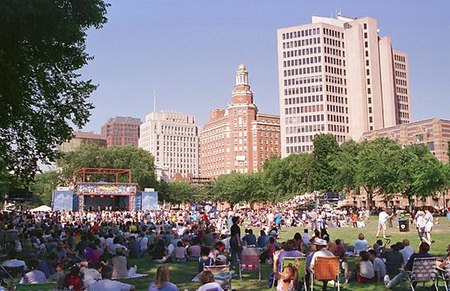New Haven Green

The New Haven Green is a 16-acre (65,000 m2) privately owned park and recreation area located in the downtown district of the city of New Haven, Connecticut. It comprises the central square of the nine-square settlement plan of the original Puritan colonists in New Haven, and was designed and surveyed by colonist John Brockett. Today the Green is bordered by the modern paved roads of College, Chapel, Church, and Elm streets. Temple Street bisects the Green into upper (northwest) and lower (southeast) halves. The green is host to numerous public events, such as the International Festival of Arts and Ideas and New Haven Jazz Festival, summer jazz and classical music concerts that can draw hundreds of thousands of people, as well as typical daily park activities. The New Haven Green Historic District was designated a National Historic Landmark District for the architectural significance of the three 19th-century churches located there.The New Haven Green is one of the oldest and most well-known town greens in the nation, dating back to at least 1638. As of July 2017, the City of New Haven offers free public WiFi on the Green.
Excerpt from the Wikipedia article New Haven Green (License: CC BY-SA 3.0, Authors, Images).New Haven Green
New Haven
Geographical coordinates (GPS) Address Nearby Places Show on map
Geographical coordinates (GPS)
| Latitude | Longitude |
|---|---|
| N 41.308031 ° | E -72.92698 ° |
Address
New Haven
Connecticut, United States
Open on Google Maps








